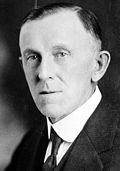November 3, 1936 | |||||||||||||||||
| |||||||||||||||||
 County results Bulow: 40–50% 50–60% 60–70% Gurney: 40–50% 50–60% 60–70% No Vote: | |||||||||||||||||
| |||||||||||||||||
| Elections in South Dakota |
|---|
 |
The 1936 United States Senate election in South Dakota took place on November 3, 1936. Incumbent Democratic Senator William J. Bulow ran for re-election to a second term. He was challenged by businessman Chan Gurney, who defeated former Congressman Charles A. Christopherson in the Republican primary. Bulow, likely aided by President Franklin D. Roosevelt's landslide victory in South Dakota, narrowly defeated Gurney to win his second term, though he significantly underperformed Roosevelt.

